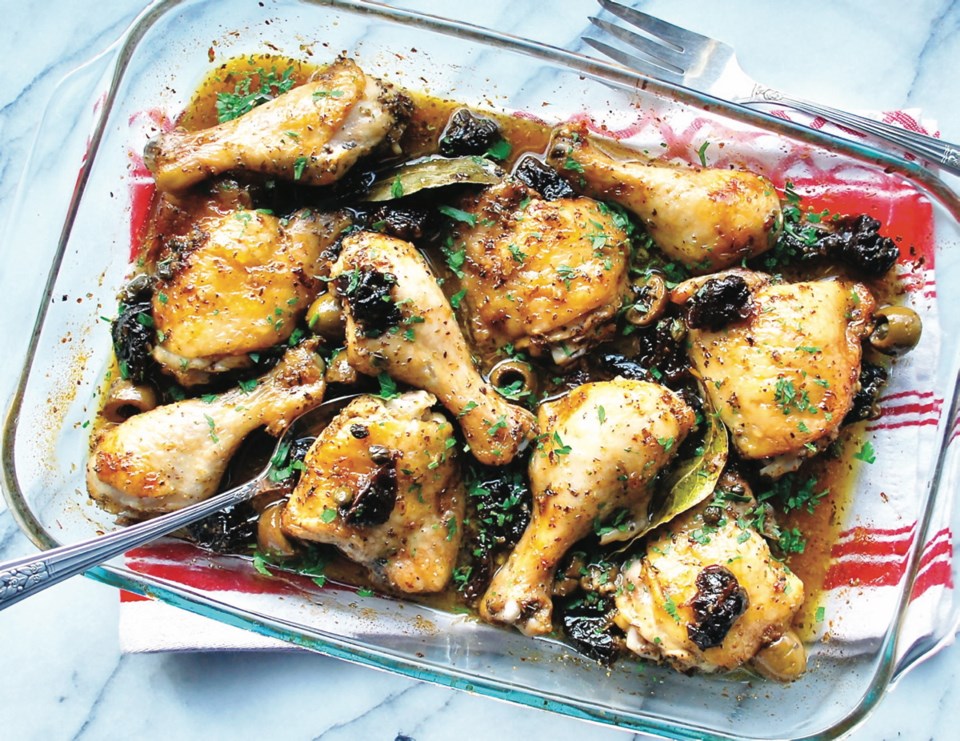The first time I tried chicken Marbella, 30Â plus years ago, IÂ found its flavour so intriguing that I immediately started musing about the origins of the dish. Since it contained ingredients such as prunes, capers, olives, wine and oregano, my first thought was that it must come from southern Europe, or maybe Northern Africa.
I was sort of right, but soon learned, as everybody else but me seemed to know at that time, that chicken Marbella was actually first dished up at the Silver Palate, a gourmet food shop in New York.
Julee Rosso and the late Sheila Lukins opened that establishment in 1977, and the initial plan was pretty simple. Lukins would prepare gourmet takeout fare at home and deliver it to the small shop. Rosso would then sell it to their on-the-run, no-time-to-cook Manhattan customers and also manage the shopâs finances.
The concept worked. The Silver Palate quickly became a successful business that rapidly expanded into a bustling enterprise, and that led to the Silver Palate Cookbook being published in 1979. The book became a mega bestseller, sold millions of copies and is still available.
I have a well-worn, often-used 1982 edition that contains a recipe for chicken Marbella. The introduction says it was the first main-course dish offered at the Silver Palate.
In a Tablet Magazine (tabletmag.com) article about chicken Marbella, Rosso told Elin Schoen Brockman that it was initially inspired by the cuisine she and Lukins encountered while travelling in Spain and Morocco, where some meat dishes were enhanced with olives and/or dried fruit.
Rosso also said that early in their relationship, she served Lukins, who was Jewish, the sweet-and-sour beef brisket that her mother used to make. That sweet and sour taste is also found in chicken Marbella.
Lukins grandparents came from Russia, and tastes they introduced to her included cooking meat with fruit, such as prunes, which, of course, are added to chicken Marbella.
With the success of the Silver Palate Cookbook, chicken Marbella became a staple at dinner parties, first in New York and then just about everywhere else the book was sold. It also became a popular dish to serve at festive Jewish occasions, such as Passover Seders.
Itâs easy to understand why it became so popular. Not only is it very tasty, itâs not that difficult to make. You marinate pieces of chicken with some of the ingredients I noted above. You then arrange the chicken in a baking dish and sprinkle it with brown sugar, which adds some of the âsweetâ in this sweet-and-sour-tasting dish. You add wine, then bake the chicken, basting it with pan juices as it cooks, until itâs a rich golden.
The Silver Palate Cookbook says you can serve chicken Marbella hot or at room temperature. For the latter, once cooked, you let it cool to room temperature in its cooking juices before transferring to a serving platter.
At this time of year, I prefer to serve chicken Marbella hot. My recipe for it is adapted from the one in the Silver Palate Cookbook.
My main tweaks were to simplify things and use chicken thighs and drumsticks rather than cutting up a whole chicken into portions. Because the weight of those chicken pieces was a fair bit less than a cut-up whole chicken would have been, I also reduced the amounts of other ingredients.
When you cook my recipe, you end up with two pans of chicken Marbella that, collectively, yield 10 two-piece servings. In other words, a tasty, festive main-course dish you can serve to a crowd during the holiday season.
Ericâs Chicken Marbella
Aromatic, richly flavoured, sweet-and-sour-tasting chicken you can serve to a crowd during the holiday season. I like to serve the chicken with couscous, orzo or rice pilaf and a green vegetable, such as asparagus or broccolini. Remember to plan ahead when serving it, as the chicken needs to marinate overnight before you cook it.
Preparation time: 30 minutes, plus overnight marinating time
Cooking time: 55 to 65 minutes
Makes: 10 (two-piece each) servings
1/3 cup extra virgin olive oil
1/3 cup red-wine vinegar
20 pitted prunes, each halved lengthwise
15 large pitted green olives, each halved widthwise
1/3 cup capers, with some of their juice
5 bay leaves
4 large garlic cloves, minced
3 Tbsp dried oregano
⢠coarse sea or kosher salt and freshly ground black pepper, to taste
10 bone-in, skin-on, chicken thighs
10 skin-on chicken drumsticks
2/3 cup white wine (divided)
1/2 cup packed brown sugar
2 to 3 Tbsp chopped fresh parsley or cilantro
Combine oil, vinegar, prunes, olives, capers, bay leaves, garlic and oregano in a bowl large enough to hold the chicken. Add the chicken, season with salt and pepper, and toss to coat. Cover chicken and marinate overnight in the refrigerator.
When ready to cook the chicken, preheat oven to 350 F. Set out two, 13-by-9-inch baking pans. Set five chicken thighs and five chicken drumsticks in a single layer in each pan. Disperse the prunes, olives, bay leaves and capers left in the bowl around the chicken. Pour any liquid left in the bowl over the chicken.
Pour 1/3 cup of white wine into each baking pan. Sprinkle each piece of chicken with some brown sugar.
Set the pans of chicken in the middle of the oven and bake, uncovered, 55 to 65 minutes, or until cooked through. Baste chicken with the juices in the pan several times as it cooks.
Serve the chicken directly from the pans. Or lift the chicken, prunes, olives and capers out of the pans with a slotted spoon and set them on a large serving platter.
Drizzle each piece of chicken with some of the juices in the pans. Pour the remaining juices into a sauceboat and serve them alongside the chicken.
Whether you serve the chicken right from the pans, or on a platter, sprinkle it with parsley (or cilantro) before serving.
Eric Akis is the author of eight cookbooks. His columns appear in the Life section Wednesday and Sunday.



